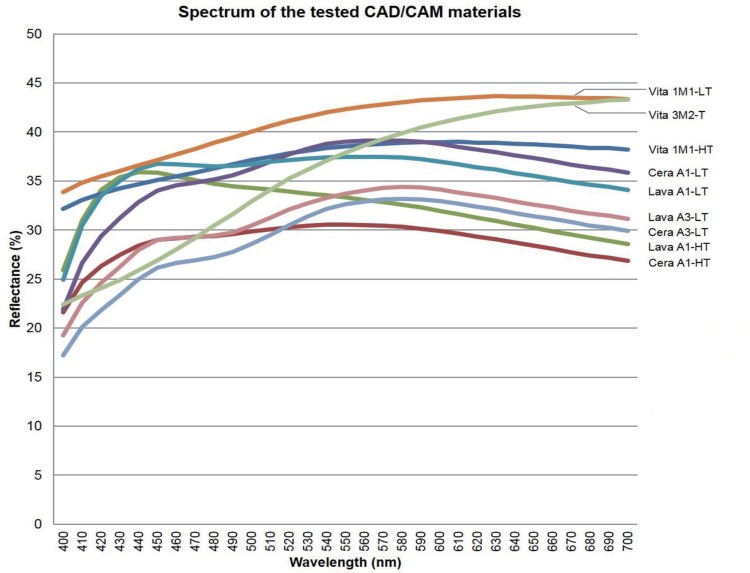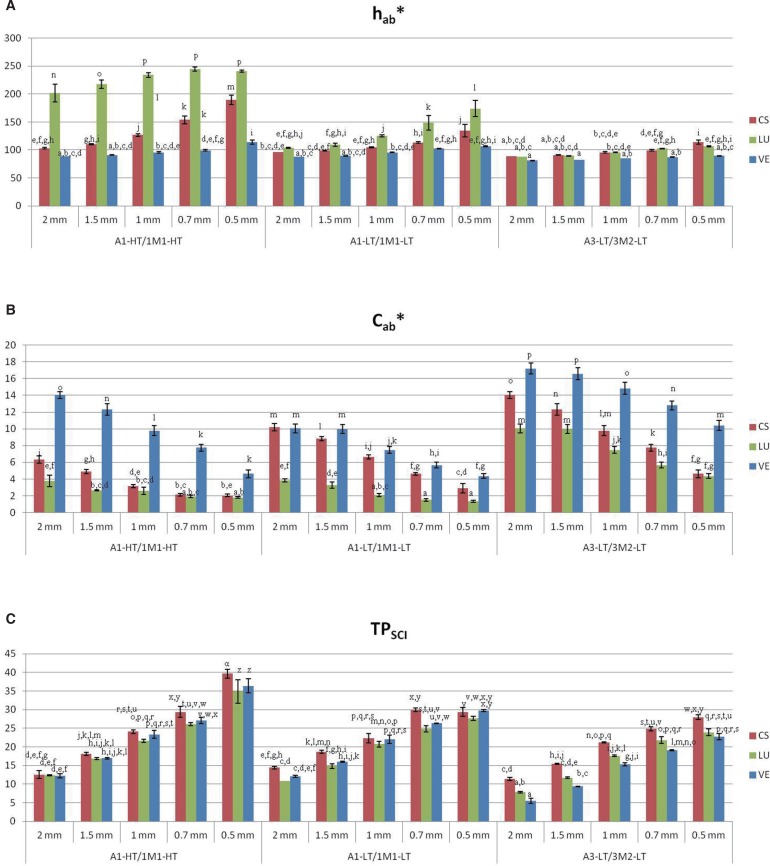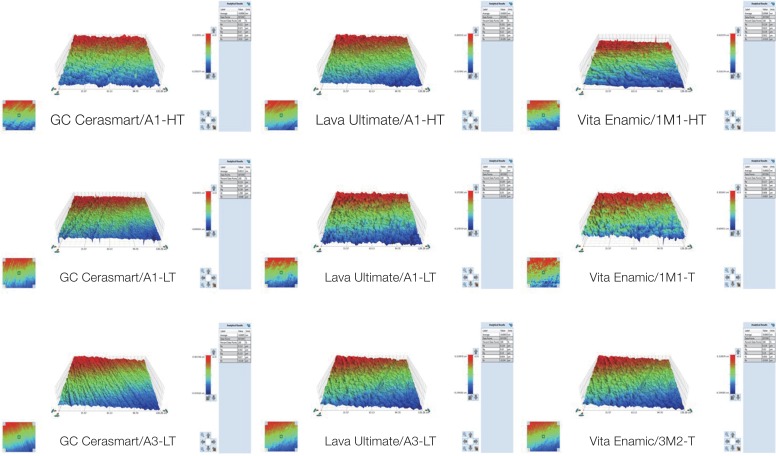J Adv Prosthodont.
2018 Feb;10(1):32-42. 10.4047/jap.2018.10.1.32.
Comparative color and surface parameters of current esthetic restorative CAD/CAM materials
- Affiliations
-
- 1Department of Prosthodontics, Faculty of Dentistry, Gazi University, Ankara, Turkey. ferhanegilmez@gmail.com
- 2Institute of Dentistry, Department of Biomaterials Science and Turku Clinical Biomaterials Centre, Turku, Finland.
- 3University of Turku and City of Turku, Welfare Division, Turku, Finland.
- 4Faculty of Health and Well-being, Turku University of Applied Sciences, Turku, Finland.
- KMID: 2403996
- DOI: http://doi.org/10.4047/jap.2018.10.1.32
Abstract
- PURPOSE
The purpose of this study was to derive and compare the inherent color (hue angle, chroma), translucency (TP(SCI)), surface gloss (ΔE* SCE-SCI), and surface roughness (Ra) amongst selected shades and brands of three hybrid CAD/CAM blocks [GC Cerasmart (CS); Lava Ultimate (LU); Vita Enamic (VE)].
MATERIALS AND METHODS
The specimens (N = 225) were prepared into square-shaped (12 × 12 mm2) with different thicknesses and shades. The measurements of color, translucency, and surface gloss were performed by a reflection spectrophotometer. The surface roughness and surface topography were assessed by white light interferometry.
RESULTS
Results revealed that hue and chroma values were influenced by the material type, material shade, and material thickness (P < .001). The order of hue angle amongst the materials was LU > CS > VE, whereas the order of chroma was VE > CS > LU. TP(SCI) results demonstrated a significant difference in terms of material types and material thicknesses (P ≤ .001). TP(SCI) values of the tested materials were ordered as LU > CS > VE. ΔE* SCE-SCI and Ra results were significantly varied amongst the materials (P < .001) and amongst the shades (P < .05). The order of ΔE* SCE-SCI amongst the materials were as follows LU > VE ≥ CS, whereas the order of Ra was CS ≥ VE > LU.
CONCLUSION
Nano-ceramic and polymer-infiltrated-feldspathic ceramic-network CAD/CAM materials exhibited different optical, inherent color and surface parameters.
Keyword
MeSH Terms
Figure
Reference
-
1. Fasbinder DJ, Neiva GF. Surface evaluation of polishing techniques for new resilient CAD/CAM restorative materials. J Esthet Restor Dent. 2016; 28:56–66. PMID: 26176202.
Article2. Koizumi H, Saiki O, Nogawa H, Hiraba H, Okazaki T, Matsumura H. Surface roughness and gloss of current CAD/CAM resin composites before and after toothbrush abrasion. Dent Mater J. 2015; 34:881–887. PMID: 26632238.
Article3. Gracis S, Thompson VP, Ferencz JL, Silva NR, Bonfante EA. A new classification system for all-ceramic and ceramic-like restorative materials. Int J Prosthodont. 2015; 28:227–235. PMID: 25965634.
Article4. Acar O, Yilmaz B, Altintas SH, Chandrasekaran I, Johnston WM. Color stainability of CAD/CAM and nanocomposite resin materials. J Prosthet Dent. 2016; 115:71–75. PMID: 26386483.
Article5. Aboushelib MN, Elsafi MH. Survival of resin infiltrated ceramics under influence of fatigue. Dent Mater. 2016; 32:529–534. PMID: 26764178.
Article6. Al-Harbi FA, Ayad NM, ArRejaie AS, Bahgat HA, Baba NZ. Effect of aging regimens on resin nanoceramic chairside CAD/CAM material. J Prosthodont. 2017; 26:432–439. PMID: 26662793.
Article7. Shembish FA, Tong H, Kaizer M, Janal MN, Thompson VP, Opdam NJ, Zhang Y. Fatigue resistance of CAD/CAM resin composite molar crowns. Dent Mater. 2016; 32:499–509. PMID: 26777092.
Article8. Della Bona A, Corazza PH, Zhang Y. Characterization of a polymer-infiltrated ceramic-network material. Dent Mater. 2014; 30:564–569. PMID: 24656471.
Article9. Awad D, Stawarczyk B, Liebermann A, Ilie N. Translucency of esthetic dental restorative CAD/CAM materials and composite resins with respect to thickness and surface roughness. J Prosthet Dent. 2015; 113:534–540. PMID: 25749093.
Article10. Güth JF, Kauling AEC, Ueda K, Florian B, Stimmelmayr M. Transmission of light in the visible spectrum (400-700 nm) and blue spectrum (360-540 nm) through CAD/CAM polymers. Clin Oral Investig. 2016; 20:2501–2506.11. Egilmez F, Ergun G, Cekic-Nagas I, Vallittu PK, Lassila LV. Estimation of the surface gloss of dental nano composites as a function of color measuring geometry. Am J Dent. 2012; 25:220–226. PMID: 23082386.12. Villarroel M, Fahl N, De Sousa AM, De Oliveira OB Jr. Direct esthetic restorations based on translucency and opacity of composite resins. J Esthet Restor Dent. 2011; 23:73–87. PMID: 21477031.
Article13. Lim YK, Lee YK, Lim BS, Rhee SH, Yang HC. Influence of filler distribution on the color parameters of experimental resin composites. Dent Mater. 2008; 24:67–73. PMID: 17420043.
Article14. Nakajima M, Arimoto A, Prasansuttiporn T, Thanatvarakorn O, Foxton RM, Tagami J. Light transmission characteristics of dentine and resin composites with different thickness. J Dent. 2012; 40:e77–e82. PMID: 22955005.
Article15. ICoI. Colorimetry. CIE 015:2004. 3rd ed. Vienna, Austria: CIE Central Bureau;2004.16. Egilmez F, Ergun G, Cekic-Nagas I, Vallittu PK, Lassila LV. Short and long term effects of additional post curing and polishing systems on the color change of dental nano-composites. Dent Mater J. 2013; 32:107–114. PMID: 23370878.
Article17. Harianawala HH, Kheur MG, Apte SK, Kale BB, Sethi TS, Kheur SM. Comparative analysis of transmittance for different types of commercially available zirconia and lithium disilicate materials. J Adv Prosthodont. 2014; 6:456–461. PMID: 25551005.
Article18. Jarad FD, Moss BW, Youngson CC, Russell MD. The effect of enamel porcelain thickness on color and the ability of a shade guide to prescribe chroma. Dent Mater. 2007; 23:454–460. PMID: 16631924.
Article19. Kim HK, Kim SH, Lee JB, Han JS, Yeo IS, Ha SR. Effect of the amount of thickness reduction on color and translucency of dental monolithic zirconia ceramics. J Adv Prosthodont. 2016; 8:37–42. PMID: 26949486.
Article20. Kurtulmus-Yilmaz S, Ulusoy M. Comparison of the translucency of shaded zirconia all-ceramic systems. J Adv Prosthodont. 2014; 6:415–422. PMID: 25352964.
Article21. Lehtinen J, Laurila T, Lassila LV, Vallittu PK, Räty J, Hernberg R. Optical characterization of bisphenol-A-glycidyldimethacrylate-triethyleneglycoldimethacrylate (BisGMA/TEGDMA) monomers and copolymer. Dent Mater. 2008; 24:1324–1328. PMID: 18420264.
Article22. Mikhail SS, Schricker SR, Azer SS, Brantley WA, Johnston WM. Optical characteristics of contemporary dental composite resin materials. J Dent. 2013; 41:771–778. PMID: 23851132.
Article23. Seghi RR, Hewlett ER, Kim J. Visual and instrumental colorimetric assessments of small color differences on translucent dental porcelain. J Dent Res. 1989; 68:1760–1764. PMID: 2600257.
Article24. Alharbi A, Ardu S, Bortolotto T, Krejci I. Stain susceptibility of composite and ceramic CAD/CAM blocks versus direct resin composites with different resinous matrices. Odontology. 2017; 105:162–169. PMID: 27456684.
Article25. Wyszecki G, Stiles WS. Color science: concepts and methods, quantitative data and formulae. 2nd Ed. New York: Wiley;1982. p. 132–133. p. 140–143.26. Yu B, Lee YK. Influence of color parameters of resin composites on their translucency. Dent Mater. 2008; 24:1236–1242. PMID: 18374975.
Article27. Kim SH, Lee YK, Lim BS, Rhee SH, Yang HC. Metameric effect between dental porcelain and porcelain repairing resin composite. Dent Mater. 2007; 23:374–379. PMID: 16540161.
Article28. Vichi A, Ferrari M, Davidson CL. Influence of ceramic and cement thickness on the masking of various types of opaque posts. J Prosthet Dent. 2000; 83:412–417. PMID: 10756290.
Article29. Kilinc E, Antonson SA, Hardigan PC, Kesercioglu A. Resin cement color stability and its influence on the final shade of all-ceramics. J Dent. 2011; 39:e30–e36. PMID: 21241766.
Article30. Turgut S, Bagis B, Ayaz EA. Achieving the desired colour in discoloured teeth, using leucite-based CAD-CAM laminate systems. J Dent. 2014; 42:68–74. PMID: 24239927.
Article31. Arnetzl G, Arnetzl GV. Hybrid materials offer new perspectives. Int J Comput Dent. 2015; 18:177–186. PMID: 26110929.32. Lauvahutanon S, Takahashi H, Shiozawa M, Iwasaki N, Asakawa Y, Oki M, Finger WJ, Arksornnukit M. Mechanical properties of composite resin blocks for CAD/CAM. Dent Mater J. 2014; 33:705–710. PMID: 25273052.
Article33. Coldea A, Swain MV, Thiel N. Mechanical properties of polymer-infiltrated-ceramic-network materials. Dent Mater. 2013; 29:419–426. PMID: 23410552.
Article34. Chaiyabutr Y, Kois JC, Lebeau D, Nunokawa G. Effect of abutment tooth color, cement color, and ceramic thickness on the resulting optical color of a CAD/CAM glass-ceramic lithium disilicate-reinforced crown. J Prosthet Dent. 2011; 105:83–90. PMID: 21262405.
Article35. Al Ben Ali A, Kang K, Finkelman MD, Zandparsa R, Hirayama H. The effect of variations in translucency and background on color differences in CAD/CAM lithium disilicate glass ceramics. J Prosthodont. 2014; 23:213–220. PMID: 23889762.
Article36. Azzopardi N, Moharamzadeh K, Wood DJ, Martin N, van Noort R. Effect of resin matrix composition on the translucency of experimental dental composite resins. Dent Mater. 2009; 25:1564–1568. PMID: 19709725.
Article37. Lee YK, Lim BS, Rhee SH, Yang HC, Powers JM. Color and translucency of A2 shade resin composites after curing, polishing and thermocycling. Oper Dent. 2005; 30:436–442. PMID: 16130863.38. Stawarczyk B, Liebermann A, Eichberger M, Güth JF. Evaluation of mechanical and optical behavior of current esthetic dental restorative CAD/CAM composites. J Mech Behav Biomed Mater. 2015; 55:1–11. PMID: 26519658.
Article39. Turgut S, Bagis B, Turkaslan SS, Bagis YH. Effect of ultraviolet aging on translucency of resin-cemented ceramic veneers: an in vitro study. J Prosthodont. 2014; 23:39–44. PMID: 23725214.
Article40. Egilmez F, Ergun G, Cekic-Nagas I, Vallittu PK, Lassila LV. Light transmission of novel CAD/CAM materials and their influence on the degree of conversion of a dual-curing resin cement. J Adhes Dent. 2017; 19:39–48. PMID: 28195273.
- Full Text Links
- Actions
-
Cited
- CITED
-
- Close
- Share
- Similar articles
-
- The effect of glazing and aging on the surface properties of CAD/CAM resin blocks
- Influence of different surface treatments on bond strength of novel CAD/CAM restorative materials to resin cement
- Evaluation of the repair capacities and color stabilities of a resin nanoceramic and hybrid CAD/CAM blocks
- Effect of surface finishing treatments on the color stability of CAD/CAM materials
- Comparison of fracture strength, surface hardness, and color stain of conventionally fabricated, 3D printed, and CAD-CAM milled interim prosthodontic materials after thermocycling





